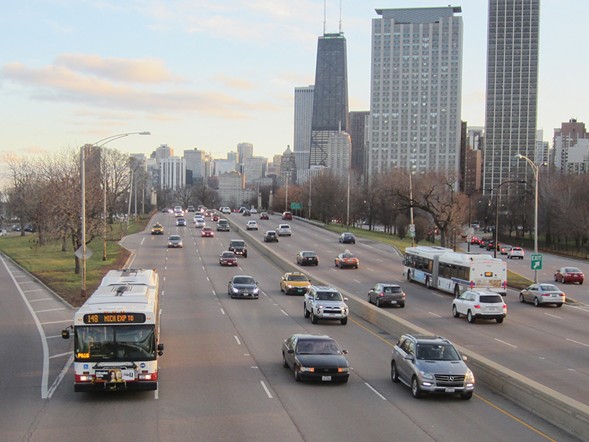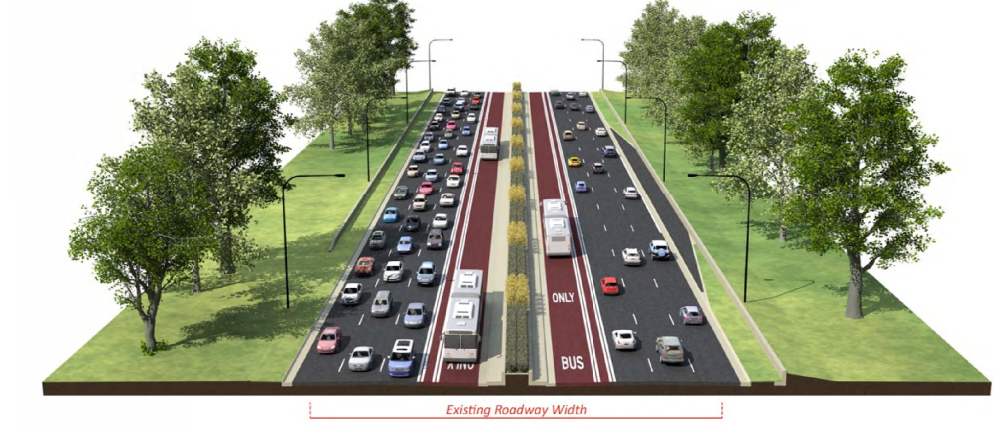During the public input sessions for the North Lake Shore Drive reconstruction study, the Illinois Department of Transportation, which has jurisdiction over the coastal highway, has indicated that it favors adding “managed lanes” to the road. These would give priority to CTA buses, as well as motorists who pay a toll for the privilege of a somewhat quicker trip. The department also hasn’t ruled out the idea of adding bus-only lanes, but if the existing number of lanes for cars were maintained, that would require widening the drive into a ten-lane behemoth, which would gobble up precious Lakefront green space.
But recently a coalition of civic and business organizations wrote an open letter to the project team, Governor Bruce Rauner, and Mayor Rahm Emanuel proposing a more sensible plan: converting two of the eight existing mixed-traffic lanes to transit lanes. The coalition includes the Active Transportation Alliance, Environmental Law & Policy Center, Friends of the Parks, Illinois PIRG, Lincoln Park Chamber of Commerce, Lakeview Chamber of Commerce, Metropolitan Planning Council, Midwest High Speed Rail Association, Respiratory Health Association, and Sierra Club Illinois.
“The reconstruction of North Lake Shore Drive is a once-in-a-generation opportunity to ‘redefine the drive’ and create a transportation corridor that prioritizes moving people rather than cars,” they state in the letter. They note that for Chicago to successfully compete with other U.S. and global cities, our transit system is going to have to accommodate more ridership in the future.
The coalition points out that currently North Lake Shore Drive is often congested with cars, mostly single-occupant vehicles, during rush hours. There are about 3,300 bus trips on the highway per day, carrying some 69,000 people, compared to 161,000 car trips carrying 256,000 people, according to the purpose and need statement for the North Lake Shore Drive reconstruction project. While buses carry 21 percent of the commuters while taking up only a small fraction of the space of cars, transit riders get stuck in the car-generated traffic jams as motorists.
The groups note that giving buses dedicated lanes would create a new rapid transit route at a low upfront cost. (They also point out that light rail could carry far more people than buses, although IDOT has written off that idea as cost-prohibitive. And while they acknowledge the department’s proposal for managed lanes would be better than the status quo, they note it wouldn’t be as effective as bus-only lanes, because the buses would still have to deal with car traffic.

“Creating a new transit service with its own dedicated lanes will make transit service faster and more reliable, creating a better service for people who already rely on transit while also attracting new riders who would otherwise drive,” the letter states.
It’s worth noting that the coalition doesn’t just include the usual suspects in terms of local sustainable transportation and environmental advocacy groups. It also includes two of the key local chambers of commerce, who understand that improving transit access while preserving or expanding lakefront parkland would be good for local merchants’ bottom line.
Coverage of the letter in Crain’s referred to this effort as a “campaign to effectively shrink the size of North Lake Shore Drive, turning over one lane in each direction for exclusive use of buses.” But, of course, dedicating lanes for bus use wouldn’t be reducing the usable space on the eight-lane highway at all, but rather reallocating the space so that a larger number of people could travel more efficiently.
Sure, the remaining six mixed-traffic lanes might become more congested for drivers (although, with less car capacity on the road it’s likely that some of them would choose to switch travel modes, or avoid unnecessary trips, a phenomenon known as traffic evaporation.) But as coalition members have pointed out, car traffic is going to be congested on Lake Shore Drive whether there are six lanes for drivers or ten. In the latter scenario the additional capacity would only encourage more care trips and the lanes would simply fill up again.
Local architect Jacob Peters counted the number of buses scheduled on Lake Shore Drives express CTA lines between 7 and 8 a.m. on weekdays, including the #134, #135, #136, #143, #146, #147, and #148, and found that 102 buses run during that peak hour. He tweeted that dedicated transit lanes would be “a great use of space when you're dealing with a corridor that averages a bus every 35 seconds during rush hour.”
You can add your name to the coalition’s letter by filling out this online form. Let elected officials know that you’re in favor adding transit lanes to Lake Shore Drive without widening the highway and destroying green space.





